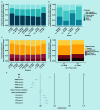The burden of acute eye conditions on different healthcare providers: a retrospective population-based study
- PMID: 38438268
- PMCID: PMC10947371
- DOI: 10.3399/BJGP.2022.0616
The burden of acute eye conditions on different healthcare providers: a retrospective population-based study
Abstract
Background: The demand for acute eyecare exponentially outstrips capacity. The public lacks awareness of community eyecare services.
Aim: To quantify the burden of acute eyecare on different healthcare service providers in a national population through prescribing and medicines provision by GPs, optometrists, and pharmacists, and provision of care by accident and emergency (A&E) services. A secondary aim was to characterise some of the drivers of this burden.
Design and setting: A retrospective data-linkage study set in Wales, UK.
Method: Analysis of datasets was undertaken from the Secure Anonymised Information Linkage Databank (GP and A&E), the Eye Health Examination Wales service (optometry), and the Common Ailments Scheme (pharmacy) during 2017-2018.
Results: A total of 173 999 acute eyecare episodes delivered by GPs (168 877 episodes) and A&E services (5122) were identified during the study. This resulted in 65.4 episodes of care per 1000 people per year. GPs prescribed a total of 87 973 653 prescriptions within the general population. Of these, 820 693 were related to acute eyecare, resulting in a prescribing rate of 0.9%. A total of 5122 eye-related and 905 224 general A&E attendances were identified, respectively, resulting in an A&E attendance rate of 0.6%. Optometrists and pharmacists managed 51.8% (116 868) and 0.6% (2635) of all episodes, respectively. Older females and infants of both sexes were more likely to use GP prescribing services, while adolescent and middle-aged males were more likely to visit A&E. GP prescribing burden was driven partially by economic deprivation, access to services, and health score. Season, day of the week, and time of day were predictors of burden in GP and A&E.
Conclusion: Acute eyecare continues to place considerable burden on GP and A&E services in Wales, particularly in urban areas with greater economic deprivation and lower overall health. This is likely to increase with a rapidly ageing population. With ongoing pathway development to better utilise optometry and pharmacy, and improved public awareness, there may be scope to change this trajectory.
Keywords: emergency medicine; eye; general practice; optometry; pharmacy; primary health care.
© The Authors.
Conflict of interest statement
The authors have declared no competing interests.
Figures





Similar articles
-
Optometry independent prescribing during COVID lockdown in Wales.Ophthalmic Physiol Opt. 2022 Nov;42(6):1289-1303. doi: 10.1111/opo.13028. Epub 2022 Aug 12. Ophthalmic Physiol Opt. 2022. PMID: 35959731 Free PMC article.
-
Analysis of UK eye casualty presentations.Clin Exp Optom. 2022 May;105(4):428-434. doi: 10.1080/08164622.2021.1937949. Epub 2021 Jul 27. Clin Exp Optom. 2022. PMID: 34315329
-
Evaluation of a minor eye conditions scheme delivered by community optometrists.BMJ Open. 2016 Aug 10;6(8):e011832. doi: 10.1136/bmjopen-2016-011832. BMJ Open. 2016. PMID: 27515757 Free PMC article.
-
Enhancing the appropriateness of eyecare delivery: the iCaretrack approach.Clin Exp Optom. 2023 Nov;106(8):825-835. doi: 10.1080/08164622.2023.2178286. Epub 2023 Feb 22. Clin Exp Optom. 2023. PMID: 36813262 Review.
-
Solidarity or dissonance? A systematic review of pharmacist and GP views on community pharmacy services in the UK.Health Soc Care Community. 2019 May;27(3):565-598. doi: 10.1111/hsc.12618. Epub 2018 Jul 26. Health Soc Care Community. 2019. PMID: 30047617
Cited by
-
New-onset double vision in general practice.Br J Gen Pract. 2025 Jan 30;75(751):92-94. doi: 10.3399/bjgp25X740781. Print 2025 Feb. Br J Gen Pract. 2025. PMID: 39890106 No abstract available.
-
Eye diseases: a global concern across age, race, and environment.Eye (Lond). 2024 Oct;38(15):2849-2850. doi: 10.1038/s41433-024-03179-x. Epub 2024 Jun 11. Eye (Lond). 2024. PMID: 38862645 No abstract available.
References
-
- Baker H, Ratnarajan G, Harper RA, et al. Effectiveness of UK optometric enhanced eye care services: a realist review of the literature. Ophthalmic Physiol Opt. 2016;36(5):545–557. - PubMed
-
- Zafar S, Sebestyen K, Qureshi Z, et al. National trends in imaging rates for eye-related emergency department visits in the United States. Am J Ophthalmol. 2020;211:114–122. - PubMed
MeSH terms
LinkOut - more resources
Full Text Sources
